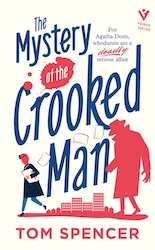When I first decided to write a mystery novel, I looked to Agatha Christie for guidance. I really love a lot of detective writers – from Arthur Conan Doyle and G.K. Chesterton to Janice Hallett and Anthony Horowitz.
But there’s no one quite like Agatha Christie. I went to the Miss Marple novel A Murder Is Announced and took it apart – I made a spreadsheet where I listed what happened in each scene, scene by scene, what we learned about each character, what clues were planted, when their significance was revealed, and so on. I thought I’d learn how to write like Agatha Christie. But when I was finished, I felt as if I had learned nothing. Then I realised I’d missed the point – or at least, a big part of the point. The brilliance of Agatha Christie only partly lies in her seeding of the text with clues – though her skill with clues is unmatched.
I felt that what I’d missed about Christie was the way in which she creates a unique atmosphere of menace. And that atmosphere is central to what makes Christie so great.
There’s a part in my novel, The Mystery of the Crooked Man, where my protagonist explains why she likes her favourite author, a thinly veiled version of Christie, so much. She talks about the title sequence of the TV adaptation of Miss Marple, starring Joan Hickson:
It featured a series of sketches [...]. Each one would at first glance depict a bucolic scene – a cricket match, a country house – and then the camera would zoom in and reveal some hidden horror. Behind the wicket lay a mangled corpse. The face of the woman standing in the window of the manor bore an expression of such vitriol that it made one gasp. This vision – not merely that the world is riddled with evil, but that its evil is both always present and always lurking just out of view – well, I stand in awe thereof.
Christie’s brilliance, for me, lies in how her work continually suggests that vision of the world, where evil is always there, just out of sight. I think it matches my own sense of the way things are, to some extent.
So when I started writing, I jettisoned my Christie spreadsheet and tried instead to create a world that felt as quietly sinister as Christie’s. I realise that makes it sound a bit like I’ve written a psychological thriller. I like a psychological thriller well enough, but that’s not my book at all. I definitely tried to stay on the humorous side of the cosy genre. But it’s all of a piece – The Mystery of the Crooked Man is written in the first person, and the main character uses humour, I think, as a defence against the awfulness she feels is lurking in the world, and so the book is funny – or at least, I hope it is!
That idea of trying to create the sense of a hidden order to the world is also behind a lot of the sneaky references in the novel. I’ve shamelessly pilfered the names of places and characters from classic detective fiction – Sayers, Doyle, and, again, and above all, Christie. One of my blurb-writers called them ‘intriguing Golden Age breadcrumbs’, and I think that’s right – as a reader, you’re supposed to feel that a trail is leading somewhere, but you’re not quite sure where. I’m sure I don’t create that sense as well as Christie does, but it’s my attempt.
While I’m on the subject, I think I wrote in the cosy genre for a similar reason. (Or at least, kind of. When I was pitching the book to agents, I called it a ‘spiky cosy’. Even though cosy narrators are often a little bitchy – Miss Marple certainly is – my protagonist, Agatha Dorn, is really pretty massively cantankerous. I was definitely trying to write a novel with a protagonist who walks the tightrope between sympathetic and unsympathetic, and I think that takes the novel slightly out of the cosy mainstream.)
But anyway, I think I wrote a cosy for reasons related to what I talk about above. In noir novels, we know the world is corrupt and screwed up from the start. It’s no surprise that it turns out to be that way. But in cosies, we’re always being lulled into this false sense that the world is nice, like a lovely village in the Cotswolds or wherever. But then, boom, we’re reminded once again that evil is all around. That sense of constantly being surprised anew by evil is unique to the cosy mystery, perhaps. And again, I think it matches my own view of the world. Constantly surprised by evil. I think that’s what I like so much about Agatha Christie – and if you like that too – and if you like funny, cantankerous protagonists – well, maybe you’ll also like The Mystery of the Crooked Man!

Pushkin Vertigo (2 May 2024)